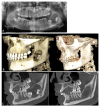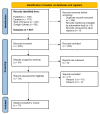Anti-MAPK Targeted Therapy for Ameloblastoma: Case Report with a Systematic Review
- PMID: 38927880
- PMCID: PMC11201667
- DOI: 10.3390/cancers16122174
Anti-MAPK Targeted Therapy for Ameloblastoma: Case Report with a Systematic Review
Abstract
Ameloblastoma, a benign yet aggressive odontogenic tumor known for its recurrence and the severe morbidity from radical surgeries, may benefit from advancements in targeted therapy. We present a case of a 15-year-old girl with ameloblastoma successfully treated with targeted therapy and review the literature with this question: Is anti-MAPK targeted therapy safe and effective for treating ameloblastoma? This systematic review was registered in PROSPERO, adhered to PRISMA guidelines, and searched multiple databases up to December 2023, identifying 13 relevant studies out of 647 records, covering 23 patients treated with MAPK inhibitor therapies. The results were promising as nearly all patients showed a positive treatment response, with four achieving complete radiological remission and others showing substantial reductions in primary, recurrent, and metastatic ameloblastoma sizes. Side effects were mostly mild to moderate. This study presents anti-MAPK therapy as a significant shift from invasive surgical treatments, potentially enhancing life quality and clinical outcomes by offering a less invasive yet effective treatment alternative. This approach could signify a breakthrough in managing this challenging tumor, emphasizing the need for further research into molecular-targeted therapies.
Keywords: adverse effect; ameloblastoma; anti-BRAF/MEK; effectiveness; targeted therapy.
Conflict of interest statement
The authors declare no conflicts of interest.
Figures





References
-
- Troiano G., Dioguardi M., Cocco A., Laino L., Cervino G., Cicciu M., Ciavarella D., Lo Muzio L. Conservative vs Radical Approach for the Treatment of Solid/Multicystic Ameloblastoma: A Systematic Review and Meta-analysis of the Last Decade. Oral Health Prev. Dent. 2017;15:421–426. - PubMed
Publication types
LinkOut - more resources
Full Text Sources
Research Materials

